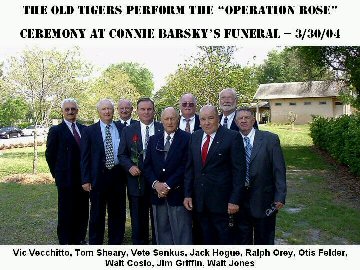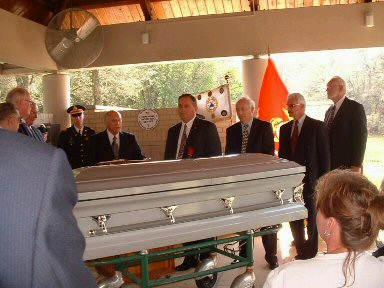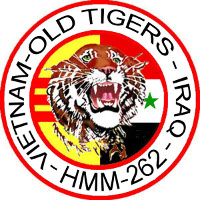|
|

Operation Rose
Click Picture to Enlarge Image


Col. Ralph Orey, USMC (Ret.) reads the Old Tigers dedication.
Connie Barsky - Leader of Marines
By Gary L. Sepulvado, Sr.
April 20, 2003
It was certainly sad but also good to read Walt Jones’s tribute to Connie in the newsletter. Like Walt, I felt the same loyalty and respect for Connie. Walt's phrasing tells the story of Connie Barsky. For example, he said, “I talked Capt. Barsky into letting us . . ..” Connie would get your loyalty instantly because he conveyed a sense of openness toward you and your ideas and had an unpretentious manner in resolving issues, whether about helicopters or about life in general. Therefore, I want to add tribute to Connie by adding one story and rounding out another one.
When I reported to maintenance after joining 262 at New River, Connie was the easiest-going senior officer that I had ever talked with. Although nothing was further from the truth, he treated me like an equal without hesitation and declared that I’d soon be the best post-maintenance test pilot in the Group, in spite of not being prepared for the job. This made me feel ten feet tall and I resolved not to let him down. I studied the manuals night and day, including weekends. He won my loyalty and respect instantly with his nonchalant and professional manner. We took a ’46 out one day for a maintenance check at New River and the controls nearly froze at 1,000 feet. Connie looked at me and said, calmly, “Wouldn’t it be nice if we had some hydraulic pressure? (Not in those words exactly but that was the sense of it.) He said, “Make the call and help me on the controls. We’ll put down in that field.” The fact that he said we would put it down and not fall out of the sky was good news to me. Moving the controls together was like trying to push a 16-wheeler down the road from a dead start. Connie was talking to our ’46 all the way down as he gained experience with the new system of controlling a ‘46: “So, if you want to go starboard, you push it forward; if you want nose up you push to port,” etc. We hit the ground somewhat level and not too hard. As we shut her down, Connie said, “You know something, we didn’t have any control at all for the last 100 feet. She landed herself.” To the contrary, if it weren’t for Connie’s calm, understanding of the control system, the ability to learn a new control system instantly, and his timing and skill as a pilot in setting up the approach while we had at least some control, we wouldn’t have had a nice, controlled crash. How could you not respect and have the greatest confidence in a Marine who comes through like that? The second story rounds out Walt Jones’s experience with getting shot down on a hill south of Chu Lai with Connie at the controls. I was the wingman who picked up Connie and his crew that day. (Don’t remember who the co-pilot and crew were.) My experience was, in fact, an expression of the loyalty that Connie engendered among the people who worked with him. To put it plainly, some sort of emotion swelled up in me saying that nothing was going to stop us from getting Connie and his crew off that hill. They were my people! Because of the lack of communication that Walt noted in his story, it was impossible to get information on the crew’s condition. After much frequency switching, garbled talk, and what seemed to be an eternity, we obtained information from the ARVN’s through our Tactical Air Control Center (“TAC,” or whatever it was called at the time). They said that Connie’s ’46 was disabled by hostile fire from the South, and the crew would have to walk down the hill since there was no place for another helicopter to land on the hill. The radios were so garbled that I couldn’t get the most important information—crew injuries? I decided that TAC was right about having no place to land but, in my estimation, they were wrong about leaving Connie and the crew on the hill overnight, especially not knowing if anyone was injured or whether medical help was on the hill. I radioed the TAC that I was going to attempt a pickup—it was the least we could do given the situation. After dumping our load far out in the dark waters of the South China Sea, we returned to the hill and saddled up to a ledge so that Connie and the crew could walk up the steps into our ’46 (more like “pull up”). It was a harrowing experience. The hill ran from west to east, the North side was cautiously safe, and the bad guys owned the South side. Three things had to be avoided because the pick-up ledge was below the hilltop on the North side: First, there was the hilltop itself and the people scurrying around on it. Second, Connie’s ‘46 was very close to the pick-up ledge and I had to stay above it. Last, the bad guys would gladly shoot down another helicopter if given a clear shot. I figured that if we took some rounds we should anticipate either a loss of power or vibration if either the engine or rotor blades were hit and, if either happened, I’d have to turn away from the hill immediately by 45-degrees and auto-rotate to a level spot. If I chopped up the hilltop or Connie’s ’46, it would be all over. In other words, while we might be able to take a few rounds, I’d better not run into anything!
The actual pickup was a sloppy affair. I couldn’t hold the hover steady for a combination of three reasons--the winds, staying out of the line of sight for the bad guys, and my lack of skill. To avoid running into anything, however, I had to expose us to the bad guys for a moment each time we made a pickup from the ledge. Thus, we actually “snatched” Connie and the crew off the ledge, one at a time, while ducking for cover between snatches. As we flew away, Connie came up to the cockpit grinning from ear to ear but looking thoroughly drained. It was great to see him and the crew in one piece. He was one of the few genuine leaders that I’ve ever met, not because a book said that he should be, but because of who he was.
SEMPER FI
A Connie Barsky Story
by Walt Jones
Right after we returned from a Caribbean Cruise in 1966, on a Friday that was a long weekend, we had a 46 go down in the boonies with a engine oil leak. I talked Capt. Barsky into letting us take some oil, and after putting oil in the engine, run it and check to see how bad it was leaking. If the leak was not too bad take off with both engines then shut the bad engine down after we get to 3000 feet as we can see the base from there. So we did and did a roll on landing and as we where taxing to get off the duty runway the other engine flamed out. The fuel control drive had failed.
Then in Viet Nam we where flying re supply to an ARVN firebase and was called for an emergency re supply for some Marines. We loaded with small arms ammo. As we where landing we took heavy fire and the turn and bank indicator was hit, plus other places. Both pilots got hit with glass from turn & bank Inc. But the AC was still ok to fly and neither pilot was seriously hurt. So went back to Quang Nagi to pick up another load of 105 ammo. When we got back to the firebase we saw that the last load we had brought in was still where we left it. We tried calling the firebase on the radio but got no answer. We stated our approach and was just flaring out when we started taking fire . One of the rounds was a golden bb as it hit the fuel filter on the left bulkhead. I yelled for the pilosts to shut # 1 down and they did right away as we hit the ground. The crew chief and I went back to the ramp and was rolling these 105 rounds off while rounds where hitting the 105 rounds . After we got the 105 stuff off we tried to take off with one engine but couldn't so we shut down and got in the trench with the ARVN's, After a little while I went back inside the plane to see if thing else was damaged , as I looked around I saw the crew chief was with me. I asked Mac if he saw any thing else that needed to be fixed and he said ever thing else seemed to be ok . After that we returned to the trench. About that time the wingman kind of hovered off to the side of our AC and we climbed in and went back to Ky Ha . Later after Top Karr and his crew recovered the AC avionics found out why we couldn't get the fire base a round hit right where the UHF and FM antennas come together taking both of them out. This was the first A/C we had shot down. Not to long after this the group CO asked then Capt Barsky to come to H&MS to help with the valve problem the 1820 in the H34 was having at that time. At reunions Lloyd Karr would alwasys tell the young Marines that Walt wrote Polly and said "don't worry honey the VC can't shoot straight". The next day he was shot down so he had to write back and tell her "they had been practicing and could shoot better now". Connie was usually with us when Lloyd was telling the story and Lloyd would say if you don't believe me ask his pilot here and of course it was true. Connie was at all the reunions Lloyd and I attended HMX, 261, 262 all eras and 262 Viet Vets I will all ways remember Lt. Col. Barsky as one of the good guys.
|

